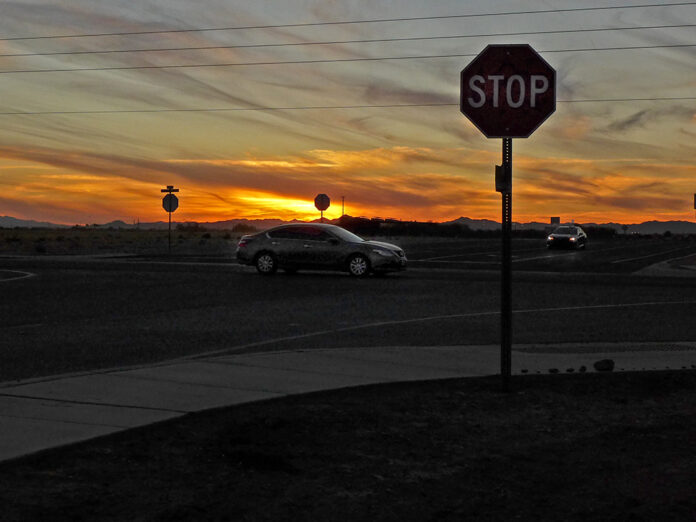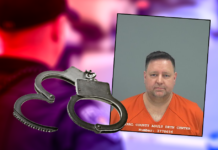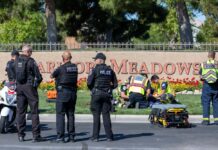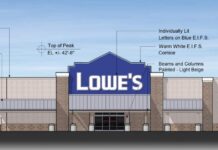
When a stretch of Bowlin Road between White and Parker Road and Rancho Mirage Boulevard opened in late August, the City was seeking to alleviate traffic congestion on some nearby streets on the east side of town.
It has worked – residents of Rancho Mirage and Sorrento can now use Bowlin instead of Honeycutt Road to head west into the city – but with a dangerous consequence: collisions with serious injuries. Especially at night, police Chief Steve Stahl reported during his Saturday morning “Coffee with the Chief” video on Facebook.
RELATED: As new stretch of Bowlin Road opens, a mile of smiles
The injuries are serious because some motorists heading west on Bowlin in the dark are failing to see, or otherwise forget about, the stop sign and continuing straight into cross traffic on White and Parker, which Stahl called a “major arterial.” The result has been several high-speed collisions.
The speed limit on that stretch of White and Parker is 45 mph, but many vehicles driving through farmland in the area south of the intersection are moving faster. At night, the intersection is quite dark.
“There have been some fairly serious-injury collisions there,” Stahl said. “We’re years away from possibly getting a traffic (signal) there.”
But Stahl said his department is working with the streets department to make the stop sign more obvious at night. He said a solar-powered stop sign that lights up in the dark has been ordered and will be installed as soon as it arrives. In addition, the streets department is going to put a trailer on Bowlin just east of White and Parker to alert drivers to the upcoming stop sign.
“We thank the streets department for their collaboration with this,” he said. “They have been tremendous … seeing some of the same things we’re seeing, and that we get right on top of it and try to mitigate it.”
Stahl highlighted several other collision-prone intersections to remind motorists to pay attention behind the wheel. The department is seeing more accidents in some locations because traffic is growing, along with the population, on “restricted or limited thoroughfares to get around the city.”
“We want to help you understand where those locations are. We encourage you to let up on the gas pedal,” he said. He warned motorists to take extra precautions, look both ways and avoid texting while driving and conversations that take eyes off the roadway.
State Route 347 at West Hathaway Avenue is one of those intersections seeing more crashes resulting from drivers on 347 making U-turns and colliding with vehicles trying to turn south onto 347.
Stahl suggested that drivers making U-turns pay close attention to vehicles trying to make the right turn from Hathaway onto southbound 347. If possible, people should try to make it clear to other drivers they intend to make a U-turn there be ready for vehicles to pull out onto 347 from Hathaway.
“It’s not that a U-turn is illegal, it’s legal, but it is one of the more dangerous maneuvers on a roadway, especially a fairly busy roadway of 347,” Stahl said.
Two dangerous intersections are canted, or not truly north-south, east-west, Stahl said.
Edison Road at 347 is one example.
“The lanes don’t quite match up so we’re seeing a lot of left-hand turns from either eastbound or westbound Edison onto southbound or northbound 347, the chief said. “As you can imagine, people are trying to make left-hand turns while other people are driving 35 miles an hour or higher on 347. That collision usually results in injuries.”
Rather than entering an intersection on a yellow signal, Stahl advised patience for motorists by waiting for the next traffic signal cycle.
Smith-Enke Road at 347 is also of ongoing concern, with officers responding there for more crashes recently, he said. Also designed with a cant, the intersection can be disorienting to motorists who are unfamiliar with its layout.
In an effort to reduce the number of red-light violations, the Arizona Department of Transportation and the City changed the turn arrows in the eastbound and westbound lanes to red, forcing drivers to stop until the signal turns green. (Right-on-red turns are not permitted at red arrows.)
“But what we are seeing now is, because people are stopping and becoming impatient, we’re seeing inattention and rear-end collisions,” Stahl said.
Accidents are occurring on Smith-Enke on both sides of the intersection, but mainly on the east side as people in a rush to get to work are pulling out in front of oncoming traffic on 347.


![Elena Trails releases home renderings An image of one of 56 elevation renderings submitted to Maricopa's planning department for the Elena Trails subdivison. The developer plans to construct 14 different floor plans, with four elevation styles per plan. [City of Maricopa]](https://www.inmaricopa.com/wp-content/uploads/2024/04/city-041724-elena-trails-rendering-218x150.jpg)

![Affordable apartments planned near ‘Restaurant Row’ A blue square highlights the area of the proposed affordable housing development and "Restaurant Row" sitting south of city hall and the Maricopa Police Department. Preliminary architectural drawings were not yet available. [City of Maricopa]](https://www.inmaricopa.com/wp-content/uploads/2024/04/041724-affordable-housing-project-restaurant-row-218x150.jpg)










![Elena Trails releases home renderings An image of one of 56 elevation renderings submitted to Maricopa's planning department for the Elena Trails subdivison. The developer plans to construct 14 different floor plans, with four elevation styles per plan. [City of Maricopa]](https://www.inmaricopa.com/wp-content/uploads/2024/04/city-041724-elena-trails-rendering-100x70.jpg)

![Affordable apartments planned near ‘Restaurant Row’ A blue square highlights the area of the proposed affordable housing development and "Restaurant Row" sitting south of city hall and the Maricopa Police Department. Preliminary architectural drawings were not yet available. [City of Maricopa]](https://www.inmaricopa.com/wp-content/uploads/2024/04/041724-affordable-housing-project-restaurant-row-100x70.jpg)